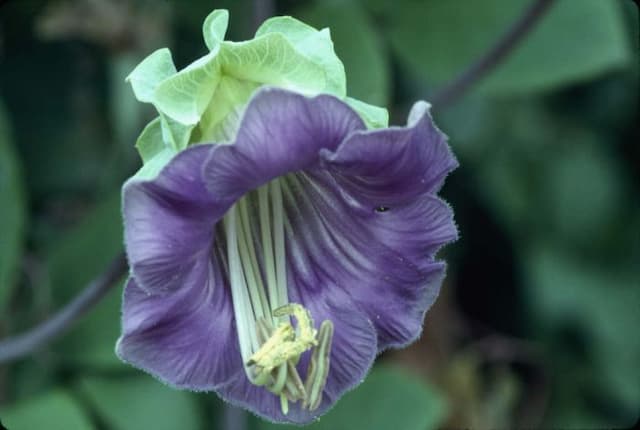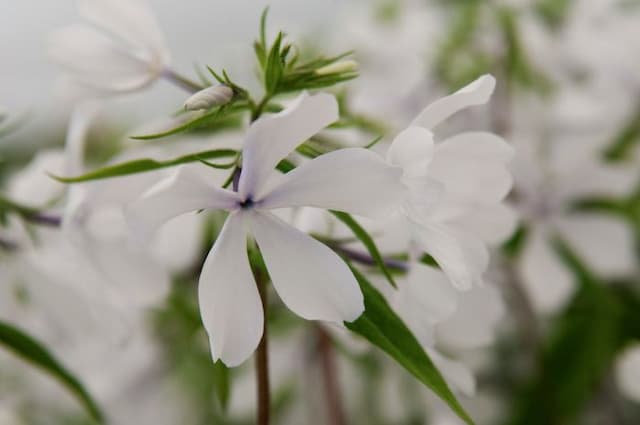Garden Phlox Phlox paniculata 'Blue Evening'

ABOUT
The garden phlox known as 'Blue Evening' is a stunning perennial plant renowned for its unique and eye-catching appearance. This variant boasts a striking bloom color which, as the name suggests, echoes the shades of a dusky evening sky. Its flowers are a blend of violet and lavender, creating a gradient effect that can range from softly muted hues to more intense purples, depending on the light. These blossoms form in large, dense clusters, commonly referred to as panicles, at the top of sturdy stems. Each individual flower is a petite, five-petaled beauty with a small, yet prominent, tube-shaped center from which the petals fan out. This center is often a slightly different hue, adding depth and contrast to the overall floral display. The leaves of 'Blue Evening' are no less attractive. They have a lanceolate shape, meaning they are longer than they are wide and have a pointed tip. The foliage is a rich green color, providing a lush backdrop for the blooms and enhancing their visual impact. The leaves emerge oppositely along the stems, creating a sense of order and symmetry that complements the natural wildness of the flowers. During its blooming season, 'Blue Evening' transforms any garden space into a serene and enchanting area, especially during the twilight hours when the colors of the flowers appear most intense. Its appeal is often heightened when planted in groups, where the collective impact of the flower clusters creates a spectacular sea of blue and purple. The overall aesthetic of 'Blue Evening' is one of romantic beauty, drawing admirers into a world of floral splendor.
About this plant
 Names
NamesFamily
Polemoniaceae
Synonyms
Garden Phlox, Summer Phlox, Fall Phlox, Perennial Phlox
Common names
Phlox paniculata 'Blue Evening'.
 Toxicity
ToxicityTo humans
Garden Phlox is generally considered non-toxic to humans. There are no well-documented cases of poisoning from ingesting Garden Phlox, and it is not commonly listed among plants that pose a risk of toxicity. However, as with any plant, individual allergic reactions or sensitivities can occur. Ingesting any part of the plant is not advised, and if symptoms of an allergic reaction or gastrointestinal upset occur after handling or ingesting Garden Phlox, it is recommended to seek medical advice.
To pets
Garden Phlox is not known to be toxic to pets. There is no significant evidence or reports of serious illness connected to pets ingesting Garden Phlox. However, it is generally recommended to prevent pets from eating plants as they might have individual sensitivities, and consuming non-food items can potentially cause gastrointestinal discomfort or an obstruction. If you suspect your pet has ingested a large amount of Garden Phlox and is showing symptoms of distress, you should consult your veterinarian.
 Characteristics
CharacteristicsLife cycle
Perennials
Foliage type
Deciduous
Color of leaves
Green
Flower color
Lavender
Height
2-4 feet (60-120 cm)
Spread
1-3 feet (30-90 cm)
Plant type
Herb
Hardiness zones
4-8
Native area
North America
Benefits
 General Benefits
General Benefits- Attracts Pollinators: This plant is known to attract bees, butterflies, and other beneficial insects, enhancing pollination in your garden.
- Aesthetic Appeal: The 'Blue Evening' variety adds a splash of vivid blue-purple flowers to the landscape, making it an attractive choice for garden aesthetics.
- Fragrance: Phlox paniculata emits a sweet fragrance that can add a pleasant sensory experience to any garden or landscape.
- Long Blooming Period: It typically blooms from mid-summer to early fall, providing long-lasting color and interest.
- Drought-tolerant: Once established, it has a good tolerance to drought, reducing the need for frequent watering.
- Ease of Care: This plant is relatively low maintenance, making it suitable for gardeners of all skill levels.
- Versatility: It can be used in a variety of garden designs, including borders, flower beds, and cottage gardens.
- Resilience: Phlox paniculata is generally resistant to deer and rabbit browsing, making it a good choice for gardens in areas with wildlife.
 Medical Properties
Medical PropertiesThis plant is not used for medical purposes.
 Air-purifying Qualities
Air-purifying QualitiesThis plant is not specifically known for air purifying qualities.
 Other Uses
Other Uses- Garden Phlox can be used as a natural dye source, with various parts of the plant offering a range of colors when processed properly.
- Pressed flower art often includes Garden Phlox for its vibrant colors and diverse shapes, providing an aesthetic element to bookmarks, cards, and framed pieces.
- This plant's petals can be used to create homemade potpourri, as they retain color and shape well after drying.
- Garden Phlox can be employed in educational activities, teaching children about pollination as it attracts bees and butterflies.
- Florists may use the stems of Garden Phlox in flower arrangements, taking advantage of their durability and height for creating depth in bouquets.
- Photographers commonly use Garden Phlox as a lush backdrop or subject in nature photography due to its striking blue hue.
- Garden Phlox contributes to biodiversity by offering nectar for a wide array of pollinators beyond bees and butterflies, including hummingbirds.
- Culinary enthusiasts sometimes use the edible flowers of Garden Phlox to decorate cakes and desserts with a touch of natural elegance.
- In a sensory garden, Garden Phlox provides a visual highlight as well as a gentle, sweet fragrance that can relax and soothe visitors.
- Garden Phlox serves as an indicator plant, aiding gardeners in recognizing soil health and the need for pollinator-friendly environments.
Interesting Facts
 Feng Shui
Feng ShuiThe Garden Phlox is not used in Feng Shui practice.
 Zodiac Sign Compitability
Zodiac Sign CompitabilityThe Garden Phlox is not used in astrology practice.
 Plant Symbolism
Plant Symbolism- Agreement - Phlox generally symbolizes agreement or unity, which can be reflected in 'Blue Evening' Phlox as a representation of harmonious relationships.
- Harmony - The dense clusters of blooms are reminiscent of a community or group working well together, hence symbolizing harmony.
- Proposals - Traditionally, phlox would be used in bouquets meant for proposals or confessions of love, and 'Blue Evening' with its serene color can represent a calm and peaceful love.
- Partnership - 'Blue Evening' phlox, due to its characteristic of blooming in connected clusters, can stand for the idea of togetherness in a partnership.
- Sweet Dreams - Varieties of phlox such as 'Blue Evening' are also associated with the sentiment of wishing someone sweet dreams, often due to their gentle and unobtrusive appearance.
 Water
WaterGarden Phlox should be watered deeply once a week, providing about an inch of water each time, which equates to approximately 0.6 gallons per square foot every seven days. During hot, dry periods, watering frequency may need to increase to twice per week. It is crucial to water the plant at the base to keep the foliage dry and prevent mildew, especially since this plant is susceptible to fungal diseases. Overhead watering should be avoided to keep the flowers and leaves healthy. Always check the soil moisture before watering; the top inch should be dry to the touch before adding more water.
 Light
LightGarden Phlox thrives in full sun conditions but can tolerate partial shade, especially in hotter climates. The best spot for this plant is in a location where it can receive at least six hours of direct sunlight each day, ensuring abundant blooms and a healthy plant. Avoid deeply shaded areas, as this can lead to poor flowering and increase the risk of disease.
 Temperature
TemperatureGarden Phlox prefers temperatures that range from 60 to 80 degrees Fahrenheit for optimal growth. The plant can withstand minimum temperatures down to 0 degrees Fahrenheit, making it suitable for hardiness zones 4 through 8. However, prolonged exposure to temperatures above 90 degrees Fahrenheit can stress the plant and lead to poor performance.
 Pruning
PruningPrune Garden Phlox to encourage bushier growth and to maintain its appearance. After the main bloom period, typically in late summer, cut back the spent flower stems to promote a second bloom. Pruning should be done as needed, usually once the flowering has subsided. The best time for a more thorough pruning is in late winter or early spring, just before new shoots appear.
 Cleaning
CleaningAs needed
 Soil
SoilGarden Phlox thrives in rich, moist soil with good drainage and a pH of 6.5 to 7.0. Mix in compost and peat moss to enrich and lighten garden soil, ensuring optimal growth.
 Repotting
RepottingGarden Phlox generally doesn't require frequent repotting and can thrive for several years before division or repotting is necessary, typically every 3 to 4 years to maintain vigor.
 Humidity & Misting
Humidity & MistingGarden Phlox is not particularly humidity-sensitive but prefers a moderate climate; it can tolerate some humidity as long as it has good air circulation to prevent disease.
 Suitable locations
Suitable locationsIndoor
Ensure bright light, proper soil mix, and good air flow.
Outdoor
Full sun, well-drained soil, ample space for airflow.
Hardiness zone
4-8 USDA
 Life cycle
Life cyclePhlox paniculata 'Blue Evening', commonly known as Garden Phlox, initiates its life cycle as a seed which, when sown in early spring under favorable conditions of warmth and moisture, germinates within a few weeks. As it grows, the seedling develops into a vegetative state with a rosette of leaves at the ground level before sending up stems. Throughout late spring and early summer, it enters a rapid vegetative growth phase where it develops taller stems and more foliage. By mid to late summer, the plant begins its reproductive phase, characterized by the blooming of fragrant, violet-blue flowers which attract pollinators. After pollination, the flowers give way to seed capsules that mature in late summer or early fall, dispersing seeds for the next generation. Finally, as temperatures drop in fall, the plant enters a dormancy period, with its above-ground parts dying back and the root system remaining alive to regenerate the next spring.
 Propogation
PropogationPropogation time
Spring-Early Summer
Phlox paniculata 'Blue Evening', commonly known as Garden Phlox, is typically propagated by stem cuttings. The best time for taking cuttings is in late spring or early summer when the plant is actively growing. To propagate Garden Phlox using stem cuttings, select a healthy, non-flowering stem and cut a 4 to 6-inch (10 to 15 centimeters) portion just below a leaf node using clean, sharp scissors. Remove the leaves from the lower half of the cutting and dip the cut end into rooting hormone powder to encourage root development. Plant the cutting in a moist potting mix, ensuring that at least one leaf node is below the soil surface. Cover the cutting with a plastic bag or place it in a greenhouse to maintain high humidity and warmth, and keep the soil consistently moist but not waterlogged. Roots typically develop within a few weeks, after which the new plant can be gradually acclimated to less humid conditions and eventually planted in the garden.









